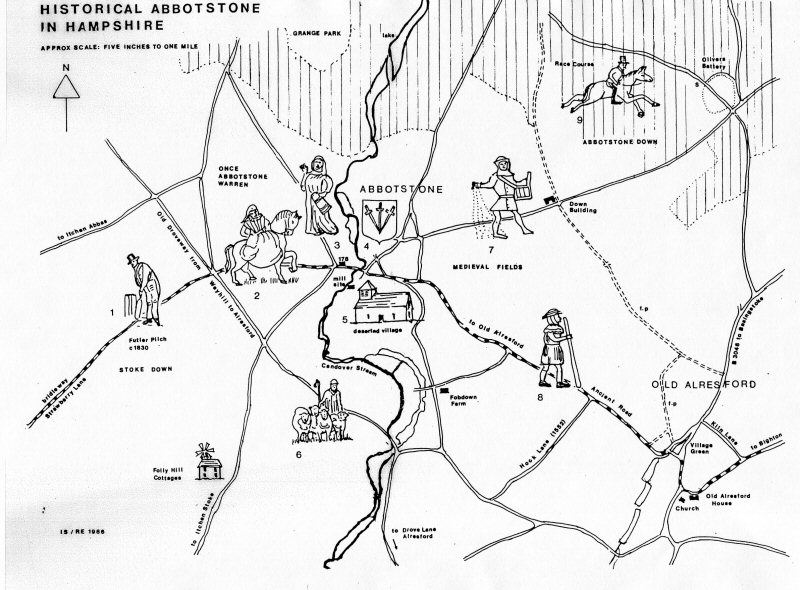HISTORICAL ABBOTSTONE

Hambledon is of course the home of cricket in Hampshire, but in 1794 the Hampshire XI were playing on Stoke Down which came to be regarded for some years as their home ground. The drawing shows "the upright bat and figure of Fuller Pilch" about 1830. An early cricket writer describes him as one of "the best batsman I ever saw".
She very probably rode down this lane with her cavalcade, when she visited Lord St. John at Abbotstone House in 1569. William Paulet, first Marquis of Winchester, 1485-1572, became Treasurer to Queen Elizabeth in 1559. Having much state business to transact in Winchester he probably felt the need of a dwelling nearby, and built Abbotstone House.
Crouch means a wayside cross at road crossings. It seems reasonable to presume she lived at the crossroads at Abbotstone. She is recorded in the tax records as paying four shillings, a large sum in those days. She was probably the wealthiest woman in the village. How did she get this wealth? - possibly by catering for travellers at her cottage or wayside inn.
Charles Paulet was created Duke of Bolton in 1689. He was the son and heir of John 5th Marquis of Winchester and was a staunch loyalist and defender of Basing House during the Civil War. In 1685 he started building Bolton House at Abbotstone. Defoe says "Tho not very large is a very handsome and beautiful place and the gardens are not only very exact but finely situate". Pavey in 1719 talks of a large noble brick house edged with stone, built for a convenient hawking site. The date on which it was destroyed seems to be unknown, but fine old panelling from Abbotstone was used at Basing c1760.
If one goes eastwards from the crossroads up the hill, the site of the village is discerned in the field on the right. There are several earthworks and well defined banks with a small enclosure on the western boundary surrounded by tall trees. Tax records of 1327 give the names of individual taxpayers, but by 1544 there were only two of these. The Black Death of 1347-49 may have been an important contributory factor to the depopulation of the village.
Trevelyan says that for a true picture of mediaeval agriculture in England, we must never forget sheep farming and the shepherd's life. Not only the great sheep farming barons, Bishops and Abbots, with their flocks counted by thousands and tens of thousands, but the peasant of the ordinary manors themselves dealt in wool. Our shepherd probably lived in the Deserted Village and is seen grazing his sheep on Fob Down.
In mediaeval England the method of cultivation was by a village community working huge unenclosed fields on a principle of strip allotments. Each farmer had a number of strips which were not adjacent. There were four large arable fields adjoining Abbotstone Down. Dell field, the nearest to the village, was cultivated in strips by plough pulled by oxen. Documentary evidence shows that the village was a flourishing community up to the early XIVc growing arable crops in the common field.
The O.S. map shows a number of roads and tracks that converged on Abbotstone in Saxon and Norman times. These were important wayfaring routes. Cochrane has numerous references to Abbotstone. He refers to Lunway coming rather north of Burntwood House and joining the complex of tracks round Itchen Wood that led to Abbotstone. Again - it can be seen how tracks from the valley road between Martyr Worthy and Itchen Stoke bend towards Abbotstone, and a visit to this "forgotten traffic centre" will disclose other tracks running south-east of Abbotstone, across the Candover Stream, on to Alresford. Our traveller is on one of these.
The first recorded race meeting was in 1805 when six horses ridden by local farmers competed for a Cup given by the Hampshire Hunt. The meeting grew in popularity and in 1820 an unusual number of carriages and spectators converged at the course on Abbotstone Down. Dinner at Alresford after the meeting had become a feature, and on this occasion, we are told it was attended by 250 race-goers! The last meeting was in 1879. Horse names were less exotic in those days and "Bonnie Dundee" won in 1873, while "Oberon" was the winner in 1879.
PREPARED AND DESIGNED BY ISOBEL SANDERSON AND PRODUCED BY THE WORKING PARTY.
Copyright.